At times I feel more in common with folks growing avocados 300 miles north of me in California’s Central Valley than I do with those just twenty miles west in Encinitas. A coastal location like Encinitas is never hot and never cold whereas the Central Valley is like my inland property: often too hot and too cold for avocados.
So I have been testing out some avocado varieties shared with me by Central Valley growers, and last week I drove all the way up to Lemon Cove and Kingsburg to tour a couple of avocado groves and learn from a few of the Valley’s tenacious farmers of avocados.
Central Valley climate
The Central Valley is the oblong basin in the middle of the state. It runs from Bakersfield in the south up to Redding in the north.
Just how hot and cold is the Central Valley? A weather station located at Fresno State University recorded an average daily high temperature during this past August of 100 degrees, and the average low temperature during this past January was 34. That’s too extreme on either end for avocados to be happy.
Central Valley avocado history
Nevertheless, avocados have been growing in parts of the Central Valley for over a century, essentially as long as they’ve been growing anywhere in California. James LaRue reported that farmers near Porterville were growing and shipping avocados to San Francisco hotels in the 1890s. And a ranch near Orange Cove grew Fuertes for forty years starting in the 1920s. Around the same time, the Duke avocado was being developed at Sunnyslope way up in Butte County. (See “The Duke Avocado.”) And we read about other established, productive avocado trees in the 1920s growing in Visalia and Fresno and Modesto, and up in Loomis and Oroville. (See “The Avocado in Northern California.”)
In the 1960s there was a wave of concerted effort to grow avocados commercially in the Valley in order to fill the harvest gap of Southern California avocados which occurred each fall. Varieties like Zutano and Bacon were planted, to be harvested starting around October, about a month before the same varieties were mature in Southern California. (See “Avocados in the San Joaquin Valley” and “Growing Avocados in the San Joaquin Valley.”) But most of these plantings have been cut down because of damage from freezes, such as the one in 1990, and because the price paid for these varieties was too low.
A few farmers remain undeterred, however. They have even planted more sensitive varieties such as Hass, Sir-Prize, and Lamb in niches of the southern Central Valley. These varieties are more sensitive to heat and cold, but at least they fetch a higher price. And the latest variety being touted as the Valley’s best chance for commercial success with avocados is GEM.
Central Valley grove tours
Around 45 people gathered on December 5 at the University of California’s Lindcove Research and Extension Center, located not far from Visalia. Most in attendance were farmers of citrus or almonds or another crop in the Central Valley, and they had come to hear about the prospects of farming avocados there, especially the GEM variety.
After a few presentations, we departed for tours of two nearby plantings.
Lemon Cove
The first grove tour was in Lemon Cove, which is on the east side of the Valley, at the start of the foothills on the road heading up into the Sierras toward Sequoia. Lemon Cove is just barely off the Valley floor but enough to remain a little less cold on winter nights compared to locations down in the flats. The owner of the grove said he hadn’t seen any cold damage on his avocado trees in the last handful of winters.
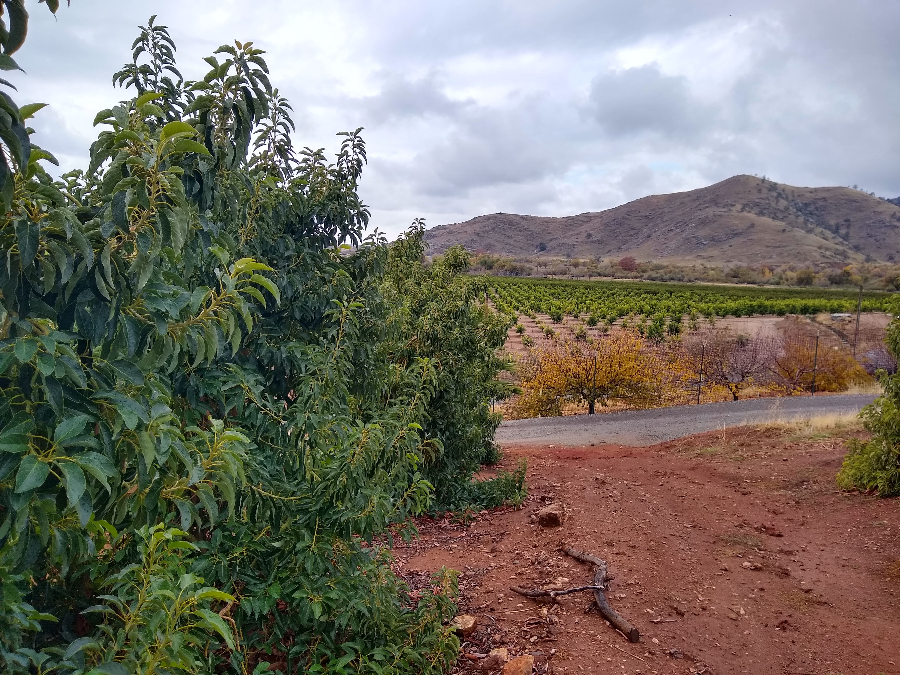
But damage from summer heat was plentiful. The south sides of the canopies of every tree showed mild to moderate damage. In addition to the normal high temperatures around 100 all summer long, early September had held an extended heat wave for the area. The trees displayed their suffering.
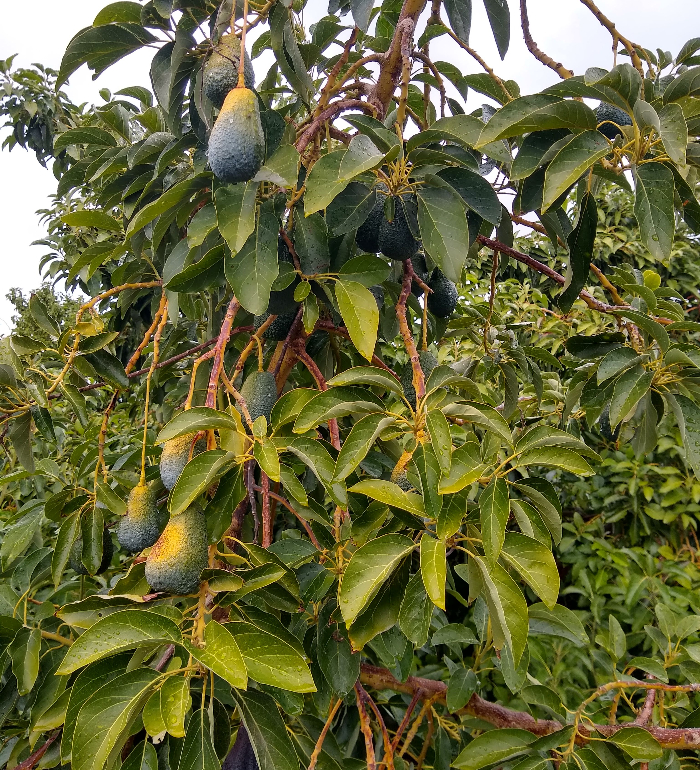
Despite the heat damage to the avocado trees in this grove, I noticed the conspicuous absence of damage to the trees’ leaves from chloride in the irrigation water. That is, the leaves had almost zero tip burn. Most avocado trees in Southern California show at least a little browning on the tips and margins of the leaves at this time of year (December), which is mostly caused by the high amount of chloride in irrigation water used down south.
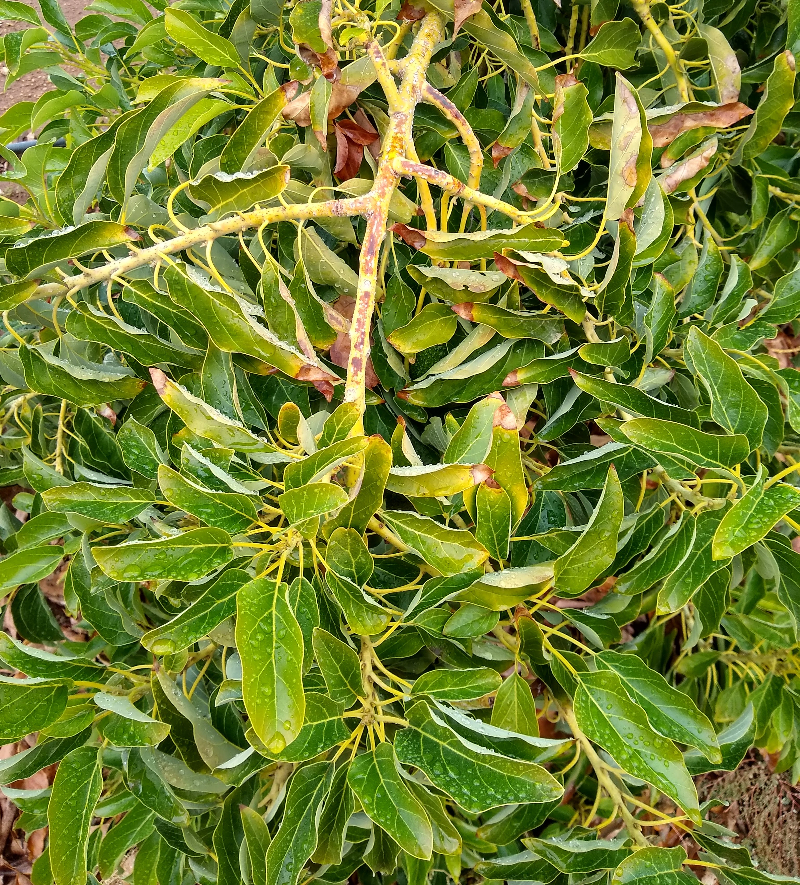
The water used for irrigation in the Central Valley has lower levels of chloride. It is therefore better for avocados. It is also cheaper and more plentiful than water available to growers in Southern California. Though the climate of the Central Valley is harsh on avocados, the water is very suitable.
Another thing I did not see on avocado trees in the Central Valley was persea mites. These tiny pests can infest trees in Southern California, especially near the ocean, causing blotchy leaves. But I saw no evidence of persea mites, possibly because of the high summer heat and low humidity.
Kingsburg
The second grove we toured was up toward Fresno and down on the valley floor on flat land near the King’s River. The owner of this planting said he had seen frost on the ground most mornings since early November. Lucky for his trees, they were protected.
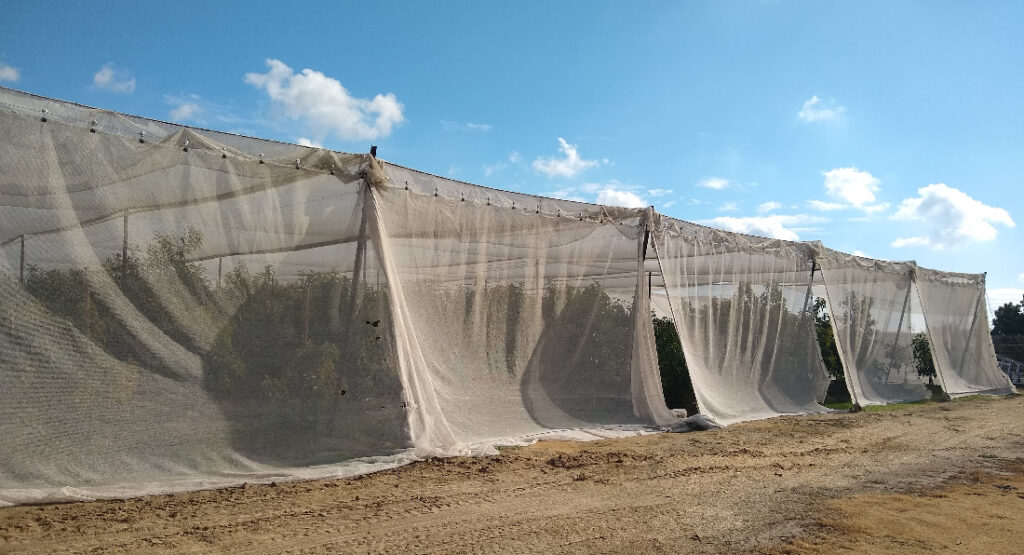
At great expense, the owner of this four-acre planting of avocados in Kingsburg had erected this structure which carried 30-percent shade cloth overhead and down all four sides. Even with that, some of the immature leaves on some of the avocado trees showed cold damage. Yet the trees showed zero damage from the summer’s high heat. The south sides of the canopies of every single tree had gorgeous, impeccable foliage.
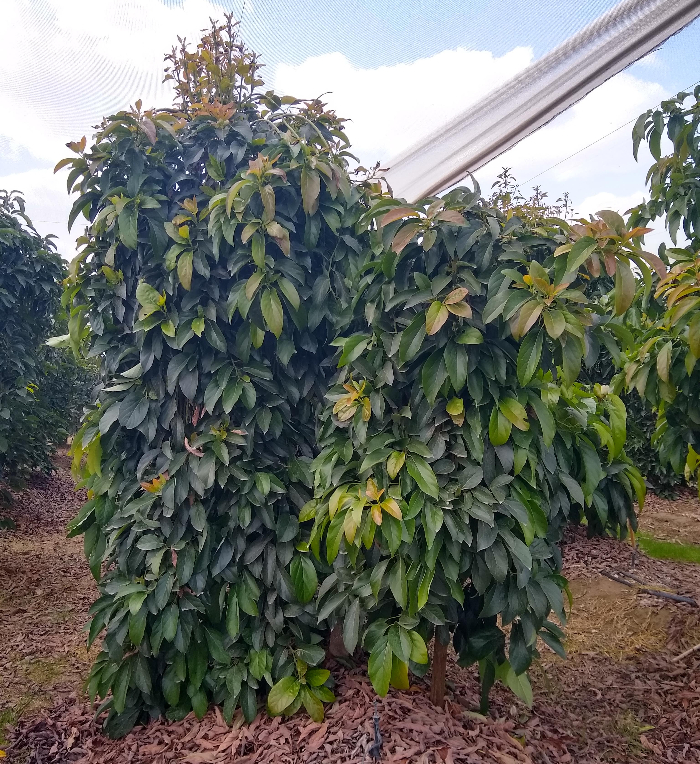
The shade cloth had clearly vanquished the power of the summer sun. It also seemed to make the trees so much more comfortable that they grew larger fruit. Both the Lemon Cove grove and this Kingsburg planting had many GEM trees of similar age, but the fruit on the trees under shade cloth in Kingsburg was larger. My guess was that this was due to the reduction of stress to the trees from the shade cloth.
Mitigating heat
So one way to make avocado trees happier in the Central Valley summers is through providing light shade. Another would be through overhead sprinklers and evaporative cooling. (See “Overhead watering for evaporative cooling on avocado trees.”) I have found both of these measures to be effective on my trees too.
There are products that coat the leaves of the tree and are said to give protection for intense sun and heat. One is called Surround; another is called Parka. A few growers in the Central Valley said they had tried these products but their opinions were mixed on whether they helped. I have not noticed a clear benefit when I have used Surround on my avocado trees during high heat.
A mulch of chipped wood under the trees helps to cool the soil for better root growth and to reduce moisture loss to evaporation. The grower in Kingsburg had a layer of wood chips under his trees, and the grower in Lemon Cove did not but said he wishes he had put some down from day one.

These measures are only effective if you are first irrigating an avocado tree sufficiently. Avocado trees need more water overall compared to citrus trees, and they need it more often. These two grove owners water their trees every two or three days throughout the summer. The Lemon Cove trees are watered with Bowsmith microsprinklers while the Kingsburg trees under shade are on double drip lines, one running down each side of each tree.
Because the season’s heat starts early in the Central Valley, usually by early June, it is best to plant new trees as early as possible once the winter’s cold threat has passed. March or April are likely the best months. This way a new tree can acclimate to its surroundings and form new roots as long as possible before dealing with the stress of high heat.
Also because of the early season heat, avocado growers in the Central Valley said they experience a lot of drop during May, June, and July if they give their trees anything less than optimal irrigation. Avocado fruitlets are small and vulnerable to heat at this time so being particularly on target with timely and ample watering is critical during this period.
Around August, the fruit of most varieties has grown big enough to weigh down branches. I find that I need to remove some fruit on south-facing branches at this point if fruitset is high because if I don’t, the branch will sag and become sunburned. I saw that this same fruit thinning needed to be applied at the Lemon Cove grove. Both thinning fruit and shortening the length of branches that face south or southwest can prevent much sunburn. You sacrifice some fruit and foliage by doing this but the fruit will be culled and the branch will be damaged anyway if you don’t.
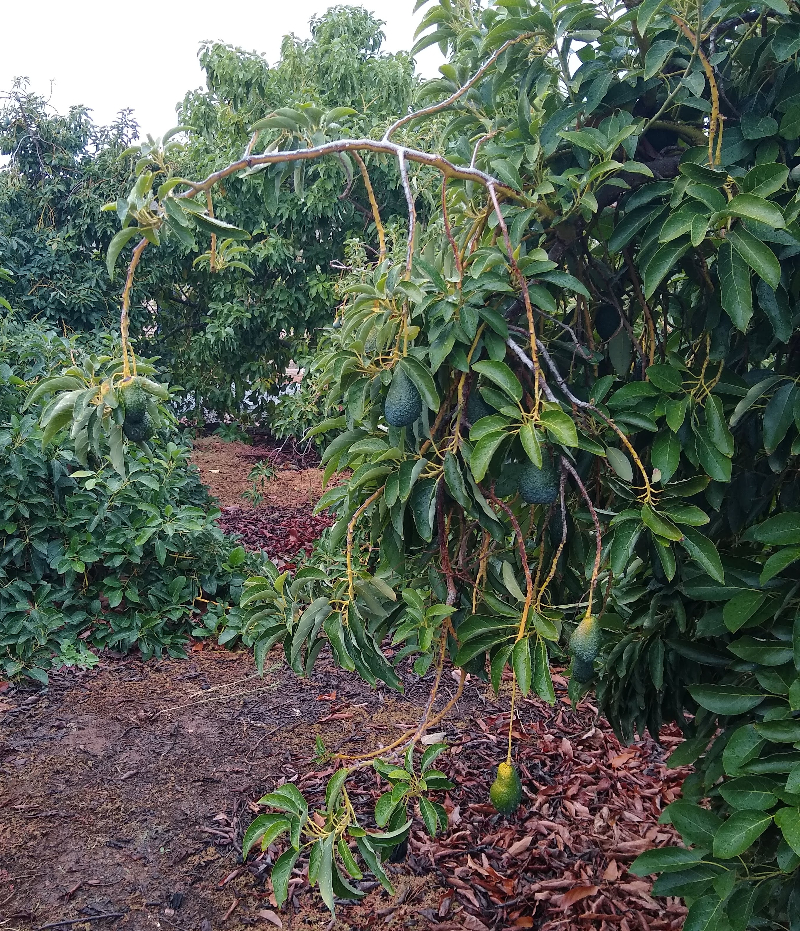
Mitigating cold
Overhead protection such as with a shade structure helps with cold just as it does with heat. With cold, the reason overhead shade cloth works is that it traps the heat that radiates up from the soil. Structures that give overhead protection of a single tree can easily be made as long as the tree is small. (See examples in my post, “Protecting avocado trees from cold.”)
Sprinklers placed above trees that are used for cooling them in summer can also mitigate cold through forming a coat of ice on the leaves. This is a common method of frost protection on avocados in Spain and Chile, I’ve been told by growers there although I’ve never tried it myself.
Just as planting as early as possible in spring helps a young tree deal with summer heat, it also helps the tree deal with winter cold since it will have as many months as possible to grow as large as possible. The larger the tree, the tougher it is in the cold, all other things being equal (health, variety, etc.).
Incidentally, the trees in Kingsburg were planted in September, but they had the shade structure for cold protection so they made it through their first winter fine.
Attempting to grow avocados in the middle of the Valley, in a location such as Kingsburg, is riskier for cold than growing in the foothills such as at Lemon Cove. The Sunset Western Garden Book distinguishes these two growing areas as Zone 8 (valley floor) and Zone 9 (thermal belt surrounding the valley floor). (See these Sunset Climate Zones here.)
My guess is that a yard within a city located on the valley floor, such as Sacramento or Stockton, might contain a microclimate that remains a few degrees warmer than nearby open countryside due to the urban heat island effect, as well as the effects of south-facing walls and similar climate altering structures. A few degrees makes a significant difference. It can be the difference between being able to grow Mexicola versus Fuerte.
Varieties for the Central Valley
Historically speaking, the varieties of avocados that have grown well in the Central Valley have been thin-skin types such as Mexicola, Puebla, Duke, Zutano, Bacon, and Susan. I’ve seen large avocado trees of these types myself in different parts of the Central Valley. Most of these varieties mature in the fall or winter. These types of avocados are often referred to as “Mexican.”
Varieties that have thicker skin and mature in the spring or summer (a year to 18 months after flowering) are more sensitive to cold and heat, unfortunately, but most folks consider them best in terms of overall eating quality. Some examples are Hass, Sharwil, Gwen, Fuerte, Reed, and Nabal. These types are often called “Guatemalan.”
Varieties from the first group perform more consistently and in more locations throughout the Central Valley whereas varieties from the second group will be damaged more often, especially during a cold winter. If I were growing avocados in the Central Valley I would test varieties from both groups.
(See my profiles of avocado varieties here.)
GEM
How about GEM? No rigorous testing has been done to determine the limits of the GEM variety in terms of heat and cold tolerance, particularly in comparison to other varieties. However, both the plantings in Lemon Cove and Kingsburg included many GEM trees growing next to trees of other varieties.
Under shade in Kingsburg, the GEM trees performed no better or worse than any adjacent variety, according to my eyes. The adjacent varieties were mostly Reed and Carmen. All of these trees looked excellent and were holding plenty of fruit.
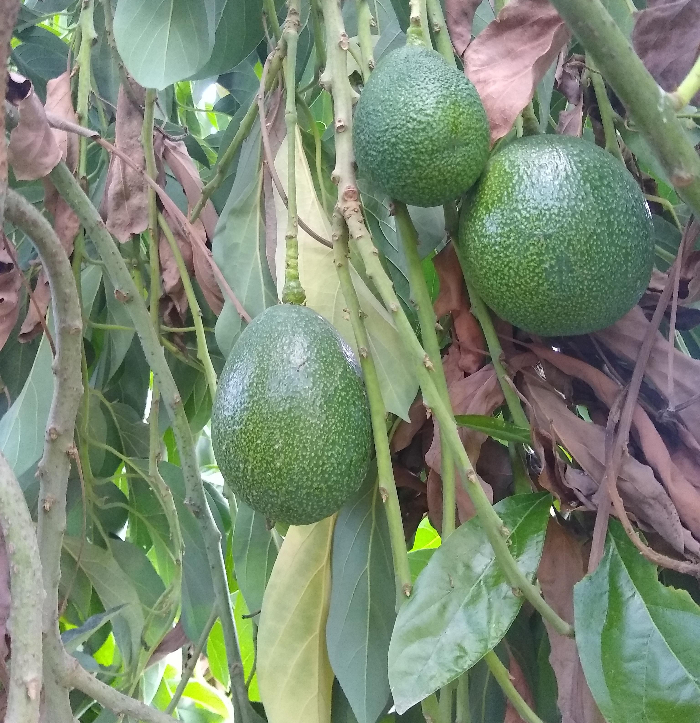
At the Lemon Cove planting, it appeared to me that the GEM trees had taken the past summer’s heat about the same as adjacent trees of the varieties Lamb, Hass, Fuerte, and Zutano, in terms of the amount of sunburned branches and leaves. I tried to take pictures of representative trees. Here are three:
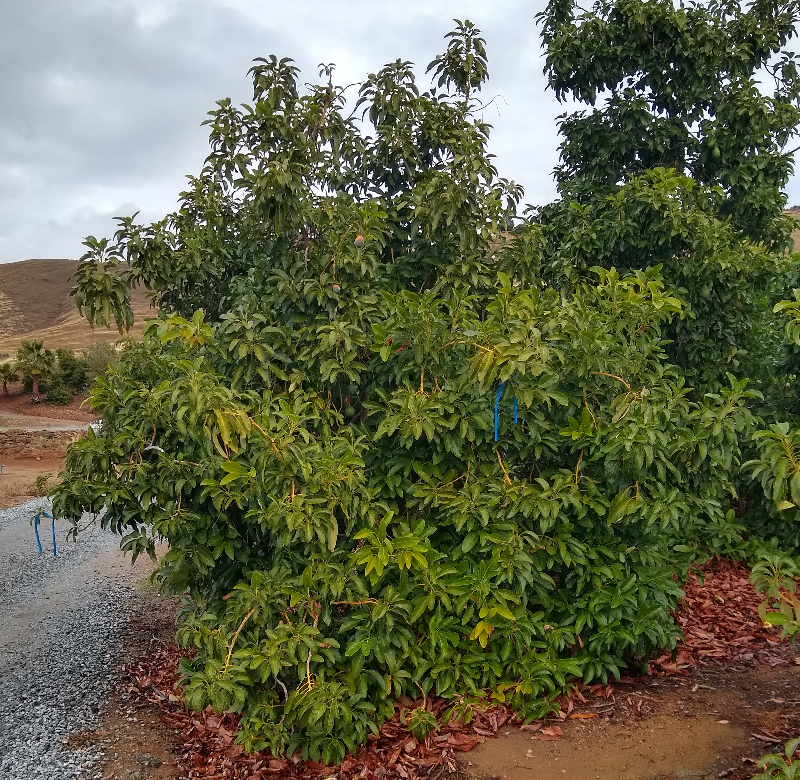
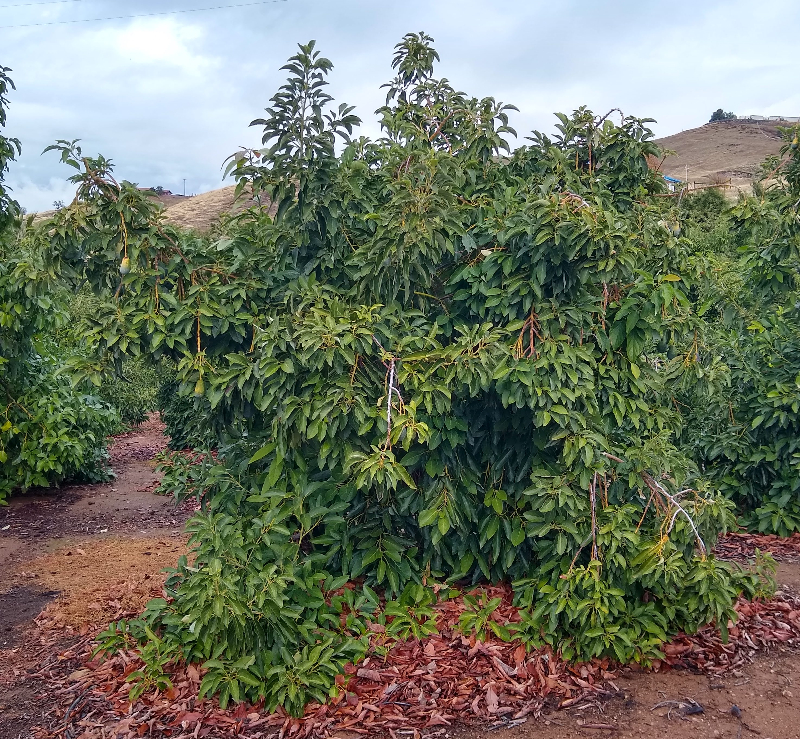
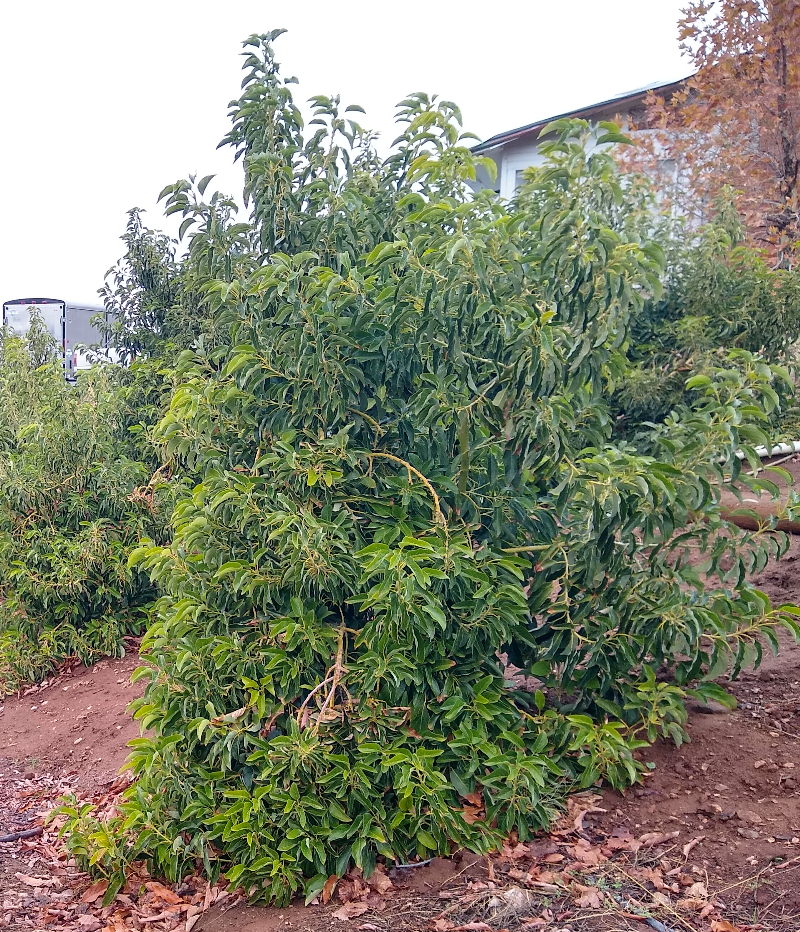
GEM did have slightly fewer sunburned avocados because it held its fruit inside its canopy more often. However, the other varieties appeared to have more total fruit (I didn’t actually count), which meant that more fruit was inevitably exposed to the sun on the exterior of the canopies of the other varieties.

GEM seems to be a variety worth trying in a warm pocket of the Central Valley. But based on the trees at those two groves, as well as those I’ve observed in my own yard and elsewhere in inland Southern California, I can’t say it’s significantly tougher in heat or cold compared to Hass or Lamb. If there is a difference, the difference is minor. Then again, a minor advantage would be an advantage all the same.
All of my Yard Posts are listed HERE
Thank you for supporting my work so there are no ads on The Yard Posts!




When I was a kid (1960) we had three huge Fuerte avocado trees in our orange grove at East Highlands, Ca. San Bernardino county. They had tremendous canopies and produced enormous quantities of beautiful fruit each year. I couldn’t put my arm around the trunks of these trees! We fertilized and irrigated them the same as the navel oranges there. The grove was situated on a high bench area where frost seldom occurred. I was always told by the old timers that growing them up north was mighty risky and not worth the effort. Now that’s the only area left for farming unfortunately.
Hi Frank,
Incidentally, I was looking at weather data from a station in that area because it’s the closest to Redlands, where I know a few groves that do really well despite the heat. The daily highs in the summer there are about the same as in the Central Valley. Like you said, the Highland and Redlands areas don’t have the same level of frost threat, however.
Some people in the avocado industry badly want to migrate things to the Valley. Land and water are cheaper. Water is higher quality. Urban expansion pressure is far less. There’s already a huge agriculture industry and infrastructure in place. But the Valley climate remains as an obstacle.
Don’t forget the FAR north like southern Oregon 🙂
Hi Rick,
It’s just one step further from a shade structure to full greenhouse protection, right?
I haven’t forgotten about your GEM tree, by the way.
Hey Greg, wish I knew about this event and that you were coming. I’m in Visalia myself. In town, I’m growing a GEM, Hass, Sir Prize, Mexicola Grande, Reed, Fuentes, and Stewart. All except the Reed are doing great. I let the Reed fruit to early after planting and it hasn’t recovered yet (been 2 years). After buying the rest in the fall back in 2020, I kept them indoors for the winter. I then planted them in raised beds, with lots of mulch, in the spring. I whitewashed their trunks and provided overhead protection during the summer. Come the following winter, I put frost blankets on them and wrapped the trees in the small Christmas lights at night. This may have all been overkill, but since then, I haven’t provided any other protection in the summer or winter, and they are doing great. I have the trees on micro sprinklers. My GEM has dropped a ton of fruit each of the last few years. I water everyday during the summer and spray the trees down once or twice during the day. I’m thinking with all that fruit drop that I need to water for longer. Moving to 14 acres soon and I’m excited about planting all these same varieties and more! Hope you enjoyed your trip to the Valley.
*Fuerte, not Fuentes
Hi Nathan,
Cool! I think it’s better to overdo the protection in the first year or two than to rely on luck with weather.
As long as the GEM tree is growing, I’d guess it will finally hold a good crop in the next spring or two since the canopy will be bigger and more protective during the late spring and early summer heat.
You can do a lot with 14 acres. Can’t wait to hear about it.
Where can I buy some fruit and come to see the trees.
I want to learn!
Thanks for sharing! Your dedication is amazing.
For us Nor Cal growers we also are always trying to figure out what thrives here. I have noticed in the winter the Mexican race trees thrive whereas the Guatemalans stop growing for the Winter.
I have a feeling that Gem has an edge because it seems to be more heat tolerant as well slightly more cold tolerant. At my location is doesn’t get very cold but it does get very hot and my Gem doesn’t seem to mind.
-Gregory
Hi Greg,
Great articles on your website!
Such challenges in those areas for growing, although GEM does show promise for sure.
We do have some production acreage in it, we’ll see how it goes.
I noticed you talked about overhead cooling – PM me if you want to chat about it, we’ve been working on it for a few years.
Thank you! Farm ACW is the most innovative avocado farm I’ve ever visited. I will get in touch to chat about overhead cooling.
Hi, I’m new to this home grown avocado thing but the tree I planted about 5 years ago has finally bore fruit. I think it is the Fuerte variety. I noticed the fruit initially because a few had dropped to the ground with what looks like the full stem on them. Is this natural “drop” or is something causing it? Fruit seems a decent size, brought them inside with high hopes. Will these ripen properly if they were drops? It was near but not at freezing for a few nights. Any info appreciated!
I love in Modesto California
Oooops, PS., I’m in Merced
Hi Carole,
It is weird if you have fruit dropping on a Fuerte tree right now. But if it’s Fuerte, then the fruit should be mature by now (or very close to mature) and should ripen just fine on the kitchen counter.
A couple years ago I contacted Brokaw in Ventura. I asked what experience they had with avocado varieties in the Central Valley, particularly what would have the best chance in the Bakersfield area on the valley floor. The immediate recommendation was the GEM. So I got GEMs and a couple Bacons on Dusa rootstock. What I couldn’t fit in my backyard I gave to friends and neighbors – because Brokaw can sell to non-commercial buyers, but in lots of 20+. I babied them through the first year with shade cloth and extra water and overhead straying in the summer and agrobon frost blankets in winter at night. Their second summer they’ve really gotten bushy and hung onto 1-3 fruits/tree (GEMs, but 0 fruits left on the Bacons). No brown tips this year since I added a filter to my water supply. I wasn’t as aggressive with shade cloth this summer and I haven’t covered them at night yet this winter, though I have string lights ready to go if a cold snap comes. They have definitely settled in and look healthy. Though it’s s
Greg
I have been reading about growing avacodos like crazy and have read many of your post and watched tons of your videos in preparation of planting a few trees in my bakersfield backyard. This is the perfect post at just the right time for me; great info!!! I just planted a large reed I purchased a couple months back; I couldn’t wait until the spring as I was too eager. I hope it wasnt a mistake planting too soon. Fingers crossed our jan/feb isn’t too cold. I have a few other 5 gal that ill plant in the spring (if i can wait). Love your content and it’s been a great help.
You might want to get a soil heating cable or incandescent bulbs to heat the tree during a cold snap. And maybe a weather station to let you know when your yard is about to get frosty!
Dan – Thanks for the comment. I’m setting up an overhead sprinkler to help mitigate heat/frost, it seems to me that for just a few trees that is the easiest solution rather than setting up shade clothes and running lights. I’m planning on running overhead water systems though any duration of frost or summer days above 100-105F. Your thoughts?
Hi Greg. Please remind me when to harvest GEM. I have beautiful fruit now. January 10.
Thanks, Tom, Fallbrook
Hi Tom,
I wouldn’t harvest GEM in Fallbrook until April. The fruit should have a blush of black on the skin by then. If you harvest before then, the skin will shrivel as the fruit ripens and the texture might be a bit rubbery and the flesh will likely be a little grassy tasting.
Greg,
Are you available to speak (or know of someone in vicinity of Merced) to a Saturday Master Gardener Community Workshop about backyard avocado
growing?
Glad I found this post. Going to try and grow some Wurtz avocado if I can find a tree locally if not I’ll order one
Hello Greg
I have read your post on avocados in the Central Valley, thank you…
I have 3.75 acres in the Springville area East of Porterville.
I have grown 6 Zutano from seed in Granada Hills (Seeds planted April 2023 – from Tyler farms) which are doing very well. I also have a couple of Hass.
I’m hesitant to plant there because of low temperatures.
Do you think it would be possible, if I plant right after last frost, and protect with shade cloth?
Thank you.
Hi Sandy,
I haven’t been through Springville, but it looks high enough off the valley floor to be a little warmer on winter nights but not too high. That’s just a guess from looking on a map and knowing some spots nearby.
My guess is that yes, you could plant right after the last frost, possibly give some light shade cloth protection (30% is probably the maximum needed; 20% is better if left on through summer), and get good growth. Then you hope for a mild winter and protect if necessary/possible during nights below freezing. Get the trees through a couple years and they become very resilient even if damaged in cold or heat.
Hello Greg….
I have a Hass Avocado that has been in the ground since May of 2021.
It has never “gone crazy” actually it has under performed, compared to another planted at the same time.
Just recently, (last 2 weeks) the top half of the 3 1/2’ tree has started to die ( I wish I could post a photo )
The bottom half seems to be green and healthy.
And thoughts as to why this is happening, or what would cause it.
Thanks!
Sandy
Hi Sandy,
That’s a weird thing for an avocado tree to do this time of year unless it was damaged by cold. But sometimes such a thing happens when the original leader chosen by the nursery dies back and the tree ultimately replaces it with fast growing shoots from down below. I’ve seen this happen many times.
As long as the bottom half continues to be green and healthy though I wouldn’t worry about it. If the bottom half begins to look unhealthy, then you’ve got a “whole tree” problem.
Hi Greg, I planted two avocado trees in my yard about 6 years ago. Got them really small at Home Depot. Needed the two for cross pollination. One is a Mexicali and the other is a Bacon. I live in a small town east of Modesto called Waterford. The trees have grown very well over the years and have seen the most fruit growing from the Mexicali tree. Each are about 12-14’ in height and have great leaf coverage (especially the Mexicali). It does get hot here throughout the summer but they seem to do fine until the winter. Seems like if we have a freeze the fruit begins to fall off shortly afterwards. That was my guess anyway. Do you find that to be a reasonable guess? Does the fruit typically stay on the tree until picked? Or am I just waiting too long to harvest maybe?
Hi Ronnie,
I have seen avocados drop after a freeze, if the temperature drops low enough for long enough. In that case, you’ll see that the stems holding the fruit turn brown before or as the fruit drops.
Mexicola does not stay on the tree as long as most other varieties though. It is mature very early (as early as August in Southern California), and as soon as it’s mature it starts to drop. So it is possible that you’re waiting too long to harvest those. As soon as Mexicola avocados’ skin get blushed with black while they’re hanging on the tree, you should think about harvesting them or keep an eye on them so you can pick them up soon after they drop.
I decided to lean in to climate change and planted two Mexicola variety avocados in my backyard in Sacramento about 5 years ago. I selected them for tolerating frost and the smaller size of the full grown tree. Because my other plants are on a daily drip timer, I took a chance and used the same watering schedule for the trees. I have them partially shaded by adjacent fence on their east side. And they definitely needed their trunks painted. The outer leaves take a hit in the heat of the summer. This Fall I have my first modest harvest of the delicious, thin-skinned fruit!